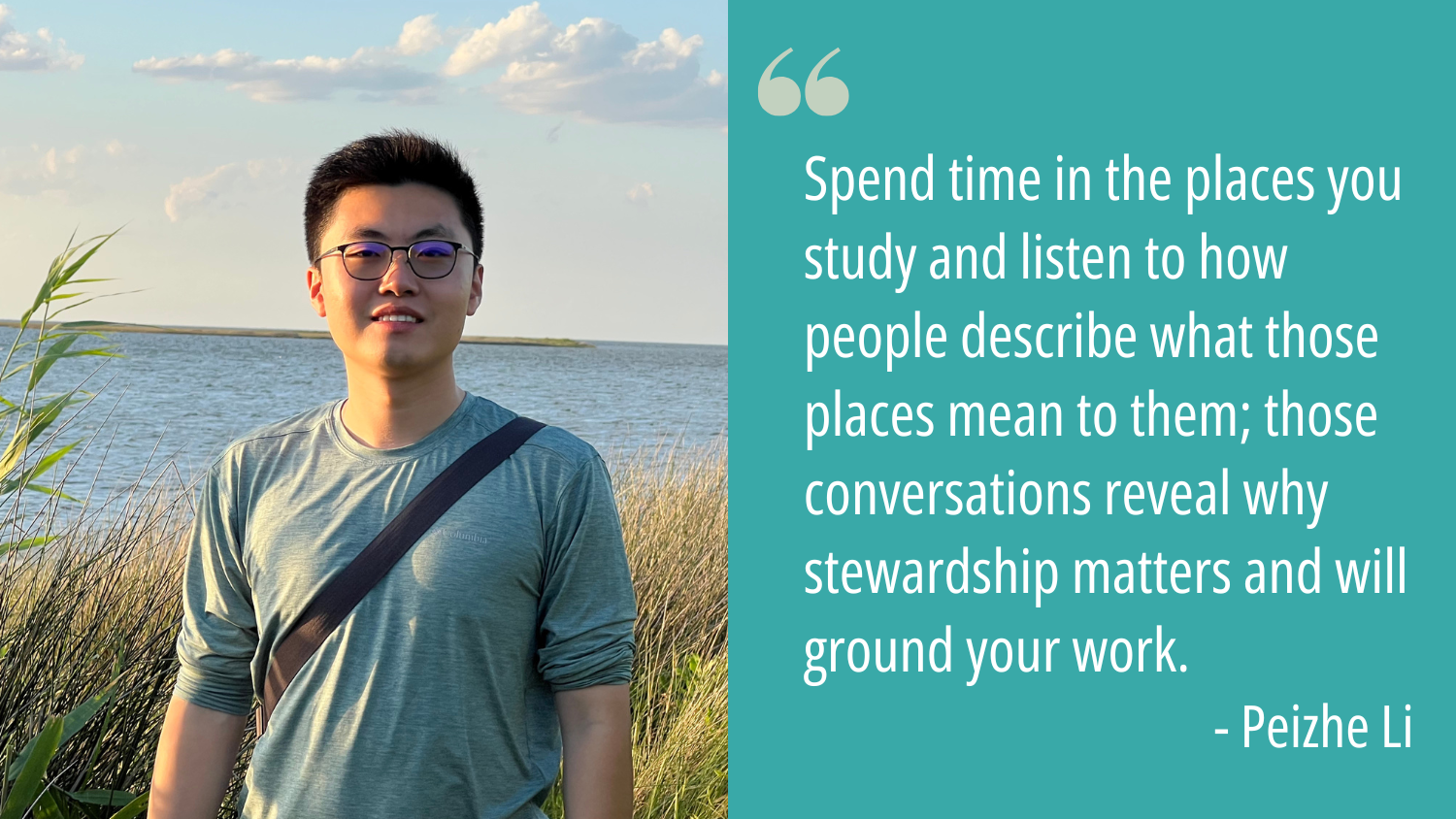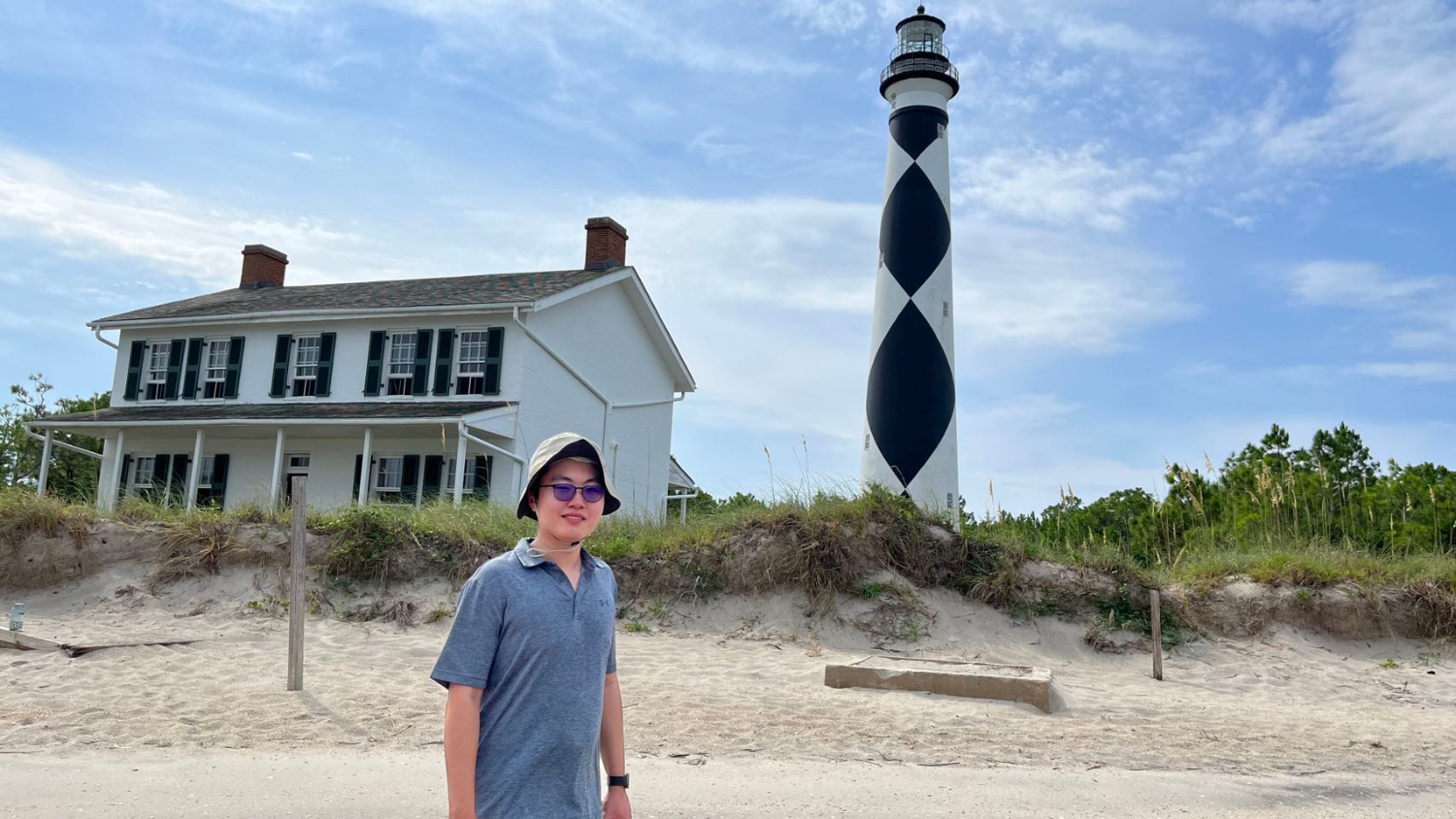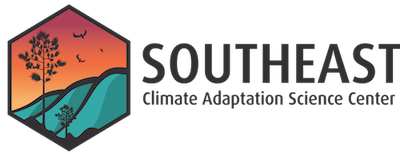Researcher Spotlight – Peizhe Li

2025-26 Global Change Research Fellow
PhD Student, Department of Parks, Recreation and Tourism Management, North Carolina State University
Advisor: Drs. Erin Seekamp and Yu-Fai Leung
About You
What do you study?
I study climate adaptation planning for cultural resources and landscapes with an emphasis on historic structures at coastal National Park Service (NPS) units. I work closely with cultural resource managers and communities to develop value-driven decision support frameworks for cultural resource adaptation planning. I also explore how different visualizations, such as maps and participatory planning tools, disseminate and transform complex scientific projections into shared spaces of conversations, supporting communities and cultural resource managers in identifying adaptation pathways for cultural resources under climate risks.
What influenced you to go into this field of study?
Growing up, my parents nurtured my love for the outdoors through everyday walks and weekend hikes with our family dog—moments that made me realize how people and places shape one another and how landscapes hold meanings that reach far beyond their physical form. During my undergraduate studies in Tourism Development and Management through the Arizona State University–Hainan University Joint International Program, I became fascinated by how visitors interpret and internalize their experiences in parks and protected areas. I began to notice that people do not simply look at nature; they negotiate what it means to them through attention, emotion, and context. My undergraduate research explored how environmental cues such as natural sounds or crowding could shape people’s multi-sensory experiences in parks and protected areas.
During my graduate studies, my advisor, Dr. Erin Seekamp, has been profoundly transformative in my approach to research. Her commitment to community collaborations and partnerships and her respect for diverse ways of knowing inspired me to think more deeply about the relationships between people and the places they value. Through her example, I came to understand that historical places are not static remnants of the past, but living archives of relationships, memories, and values. This perspective continues to shape how I approach climate adaptation for cultural resources and landscapes, as it is not simply about preserving structures but also about understanding how communities construct meaning, continuity, and identity under environmental change.
What do you think is the most pressing issue related to global change?
I believe the most pressing issue is the continued risks to cultural meanings, place-based identities, and emotional attachments that people hold toward natural and cultural resources, and how different interest-holders navigate collective decisions in response. Too often, dominant frameworks still conceptualize global change primarily as biophysical or economic challenges, overlooking how environmental loss erodes people’s sense of belonging, cultural continuity, and intergenerational connections to place. A place-centered and community-engaged approach allows climate adaptation decision-support tools to reflect the values, identities, and attachments that shape what is at stake for different interest-holders in these places and landscapes. Resource stewardship needs to anticipate the spatial and temporal risks to these connections and respond through transformative adaptation pathways that honor shared values while preparing for the realities of a changing landscape.
About Your Research
What results are you finding?
My M.S. thesis was focused on community members’ place connections and adaptation pathways for cultural resource stewardship in Cape Lookout National Seashore under climate stressors. Specifically, we found that preferences for adaptation strategies are guided by place connections and that family place connections are sensitive to climate impacts. We also examined how communities navigate post-storm decisions. While full recovery remains preferred over time, support for retention—stabilizing structures with limited access—increases as trade-offs are communicated. Even though most people were hesitant to “letting go” of historic structures (i.e., disinvestment in the maintenance or recovery of historic structures), we found clear tipping points for “letting go” when access to historic districts is reduced to less than half of the year and when fewer than 50% of buildings remain on the landscape.

Who will benefit from your research?
This research directly benefits cultural resource managers, coastal communities, and policymakers navigating complex adaptation decisions under uncertainty. For the NPS, the research supports evidence-based decisions on when to resist, direct, or accept cultural resource transformation. For local partners and residents, the participatory process ensures that their values and perspectives are embedded in future adaptation planning decisions on the historic structures and cultural landscapes to which they are connected. Ultimately, the broader conservation field benefits from studies that integrate the sentiments of interest holders, such as their preferred pathways of adaptation.
How would you describe your research to a 3rd grader?
Imagine you built a sandcastle near the ocean. The waves keep getting stronger each year. I help people decide whether to build stronger walls, move the castle to higher ground, or take a picture before the tide comes in—so that we can always remember it. My job is to make sure the stories those castles tell never disappear, even if the sand does.
About Your Global Change Research Fellow Experience
How do you expect the SE CASC Global Change Research Fellows Program to impact you and your work?
The SE CASC Global Change Research Fellows Program is shaping how I approach collaboration, partnership, and the social dimensions of science. Through its hands-on team synthesis project and the Climate Adaptation Science Field Intensive, I am learning more about how interdisciplinary teams co-produce knowledge and translate it into actionable outcomes. The program’s weekly guest speakers and training are further expanding my understanding of science communication, co-production, and engagement with diverse interest-holders.
What advice would you give to a student that is interested in getting involved in your field?
Spend time in the places you study and listen to how people describe what those places mean to them; those conversations reveal why stewardship matters and will ground your work. Believe in yourself and be patient—meaningful work takes time, and be sure to celebrate small successes, trust your growth even when the path feels uncertain, and reach out to your mentors, colleagues, friends, and family for support when you need it.
What has been the most rewarding part or your favorite part of being a SE CASC Global Change Research Fellow?
The most rewarding part has been the SE CASC community—the people I have met and the experiences I have gained through this fellowship—and I am truly grateful for all of it.
Learn more about the Southeast Climate Adaptation Science Center’s Global Change Research Fellows program.
- Categories:
